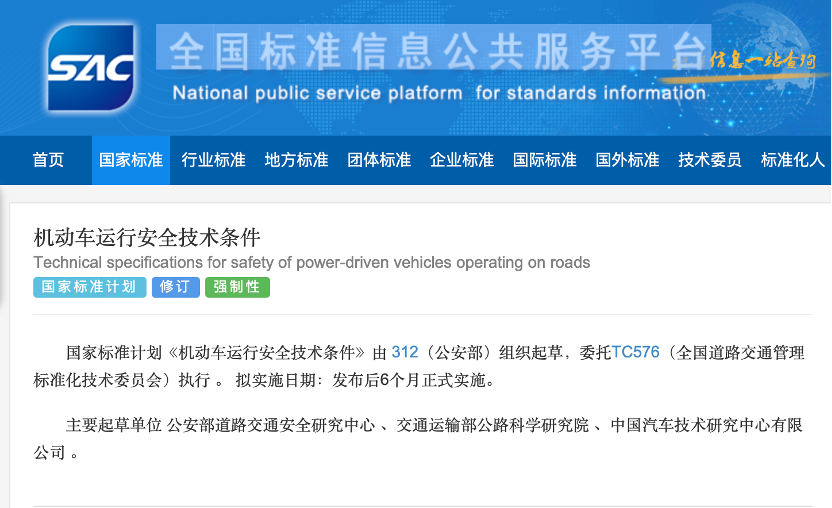
The new national standard adds overspeed warning and speed limit functions for passenger vehicles.
On November 12, according to the official website of the National Standards Information Public Service Platform, the Ministry of Public Security solicited public opinions on the draft national standard "Technical Conditions for Safe Operation of Motor Vehicles". The main drafting units of this standard include the Road Traffic Safety Research Center of the Ministry of Public Security, the Highway Research Institute of the Ministry of Transport, and the China Automotive Technology and Research Center Co., Ltd. It is planned to be officially implemented six months after the release of the draft for comments, replacing the current GB 7258.

The standard drafting working group stated that GB 7258 is the most basic technical standard for motor vehicle safety management in my country, and it is widely used in related fields such as motor vehicle manufacturing, import, quality inspection, registration, safety technical inspection, and operational safety management. However, based on recent practices in my country's road traffic management and the development of motor vehicle safety technology both domestically and internationally, the current 2017 version of GB 7258 is no longer adequate to meet the needs of the new situation.
In recent years, the penetration rate of new energy vehicles and passenger cars with driver assistance functions in my country has increased rapidly, and related traffic safety hazards and accidents have also gradually increased. However, the current standards and related technical requirements are lagging behind and cannot meet the needs of high-quality development of the automotive industry and modernization of traffic safety governance.
Regarding changes to the main technical aspects of new energy vehicles, the draft for comments points out that the operational safety requirements for new energy vehicles will be further improved to ensure their safe and high-quality development.
Specifically, the changes include: First, adding requirements for Type A regenerative braking systems and standardizing the application of the "one-pedal" mode. Second, adding requirements for pedal mis-application acceleration suppression functions, requiring electric and plug-in hybrid passenger vehicles to have this function. Third, adding safety application requirements for in-vehicle entertainment systems, requiring that when the vehicle speed exceeds 10 km/h, the driver's side display screen should be turned off and entertainment video playback and game functions should be prohibited. Fourth, adding safety requirements for the power batteries of new energy vehicles, clarifying that the power batteries of pure electric vehicles and plug-in hybrid electric vehicles should comply with the provisions of GB 38031, and the vehicle body should be equipped with directional pressure relief and pressure balancing devices.
Meanwhile, the draft for comments adds safety technical requirements for assisted driving vehicles to guide and regulate their development. These include: 1) adding activation and deactivation conditions for integrated driving assistance systems; 2) adding requirements for driver hand-off and line-of-sight detection; 3) adding requirements restricting the authorized use of integrated driving assistance functions by specific drivers; 4) adding requirements for driver-machine interaction with integrated driving assistance systems; and 5) adding requirements for explanations regarding integrated driving assistance systems in the instruction manual.
For example, in the system activation phase, the draft for comments establishes a safeguard mechanism that combines proactive operation with multi-condition verification. It specifies that each time the vehicle is powered on or started, the system can only be activated if the driver performs the prescribed activation procedure and multiple core conditions are met simultaneously. These conditions include not only fastening the seatbelt, but also the availability of driver disengagement detection and the activation of the automatic emergency braking system, among other things.
Furthermore, verifying the driver's ability to use the system is another key requirement. The draft for comments proposes that each time the vehicle is powered on or started, at least one of two methods—biometric identification or account login—must be used to confirm that the driver has completed system usage training. This requirement, through mandatory training and verification, can effectively improve the driver's understanding of the system and reduce risks caused by improper operation.
It is worth mentioning that the "draft for comments" also focuses on the problem of loss of control caused by excessive acceleration of new energy vehicles in recent years.
The draft for comments adds two new requirements for passenger vehicles in the technical indicators of "overspeed alarm and speed limit function": First, it stipulates that passenger vehicles should be in a default working state with a 100 km/h acceleration time of not less than 5 seconds every time they are powered on/started (excluding automatic engine start-stop).
Secondly, it requires that pure electric and plug-in hybrid passenger vehicles should have a pedal mis-press acceleration suppression function, which can detect and suppress power output when stationary or crawling, and alert the driver through a clear signal device (such as an audible or visual signal).
In addition, regarding car doors, the draft for comments adds that "for cars equipped with electronically controlled door locking systems or automatically activated door locking systems, the non-collision side door should automatically unlock when the irreversible restraint device is deployed or when a thermal event occurs in the power battery."
The draft for comments also adds more detailed requirements for electric door handles: If an electric interior door handle is installed, an interior door handle with mechanical release function should also be provided as a mechanical emergency interior door handle, and a corresponding conspicuous sign should be placed near the mechanical unlocking and opening device. Each door of the vehicle (excluding the tailgate) should be equipped with an exterior door handle with mechanical release function . The system design should ensure that, when the locking device is in the locked state, in the event of an irreversible restraint device deployment or a power battery thermal event, the non-collision side door can be opened without tools using the exterior door handle .


